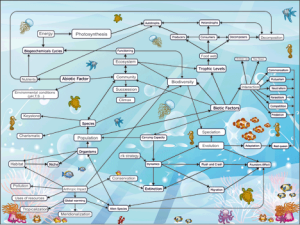Link: http://popplet.com/app/#/1571354
Last week’s activities asked us to apply our network questions to the Ecology readings of Syverson, Spellman, the Cary Institute, and fill in the gaps with Guattari, resulting in new connections for my mind map. And even though Syverson’s was the “applied Franken Theory” example, I really found that article the most compelling (thanks to its connection to Composition, relating back to my OoS). It situated the theory in an already moving, dynamic system with concrete nodes of application and inquiry, reminding me that this is exactly what we’re creating in Popplet.
My take-away from this week’s map has to do with the ways in which definitions shape our application of theory. Granted, that is an obvious observation, but thinking of ecology in terms like agency, networks, and nodes made me realize what a very useful theory it will be when working with my OoS: MOOCs. Even though, as Dr. Julia pointed out, the Academy sees Ecology as a “mushy” science, I believe it is that flexibility that makes it such a dynamic and useful framework with which to examine complex systems — and composition classrooms are certainly complex. One of our group members in our Google Doc activity last week posed this question: “What is “meaning” in the ecosystem? Is it the interaction among environment, organisms? Is it the tension between these?” This question of meaning must certainly begin with the way we define an ecosystem, and since meaning evolves from perspective, our role and position within that ecosystem — our agency as participants — must become part of our analysis (or so says Guattari).
Our class conversation pointed to a possible reason why I was not entirely comfortable with Latour’s ANT approach, one which Ecology may answer. When we deal with humans and technologies and communications, the variables resist the sort of “flattening” Latour asks us to do. As Dr. Shelley remarked, Latour’s emphasis is on the individual’s trajectory, not the group itself. While this certainly serves a useful purpose in some situations, in systems within which collaboration and connections are as dynamic as they must be in an “ideal” composition classroom (where the teacher is not the arbiter of perfect knowledge), I’m not always convinced the individual writer is the only player with agency. As the ecological readings point out, it often comes down to how we “scale” what we’re theorizing.
So, in my mind map for this week, I “up-scaled” an image to try to show “the big picture.” I made several new connections between our recent readings and some of our previous topics (Foucault as well as the “Where I Write” activity) based on this sense of being part of this emerging ecology of thinking, reading, and theorizing (although I think the Ecology readings could connect to every node in my map in some way). Thus, this is why I included an image (or “snapshot,” as Dr. Shelly called it) of the entire network as one of my Popplet nodes with the subtitle, “Ecologies: What It’s Really All About.” Here is where Guaterri makes a big difference for me — humans / students / teachers are not simply observing the ecosystem. As participants and framers simultaneously, we must see ecology — not from the God’s eye view — but through a lens placed “deep in the weeds,” as part of that ecosystem, with an awareness that as the ecosystem changes we are changed as well. It’s always already in motion.


